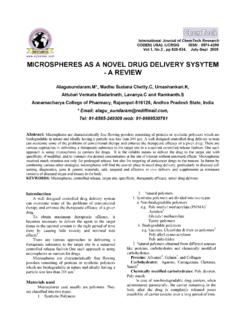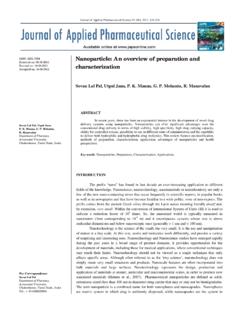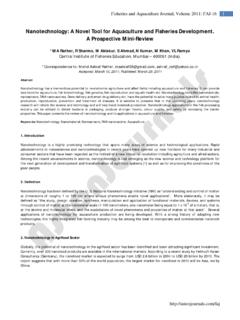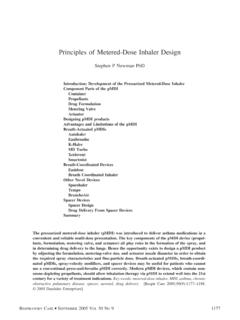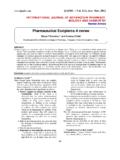Transcription of INTRODUCTION NOVEL DRUG DELIVERY SYSTEM I. II.
1 1. INTRODUCTION NOVEL drug DELIVERY SYSTEM The aim of NOVEL drug DELIVERY SYSTEM is to provide a therapeutic amount of drug to the appropriate site in the body to accomplish promptly and then maintain the desired drug concentration. The drug - DELIVERY SYSTEM should deliver drug at a rate control by the necessarily of the body over a specified term of treatment. 1 This idealized objective switch to the two aspects most important to drug DELIVERY are as follows, I. Spatial drug DELIVERY : Targeting a drug to a particular organ or tissue. 2,3 II. Temporal drug DELIVERY : The drug DELIVERY rate to the target tissue is controlled. The prime areas of research and development for NDDS are: Liposomes Niosomes Nanoparticles Transdermal drug DELIVERY Implants Oral SYSTEM Micro encapsulation / Microcapsules Polymer in drug DELIVERY NOVEL drug DELIVERY SYSTEM can be divided into classes.
2 4,5 1. Sustained release drug DELIVERY SYSTEM . 2. Controlled release drug DELIVERY SYSTEM . Sustained release drug DELIVERY SYSTEM It is a pharmaceutical dosage from formulated to retard the release of a therapeutic effect such that its look in the systemic circulation is delayed and/ or prolonged and the plasma profile is sustained in duration . The onset of its pharmaceutical action is often slow, and the duration of its therapeutic effect is sustained. (eg: coated granules) Controlled release drug DELIVERY SYSTEM This SYSTEM has a meaning that goes beyond the scope of sustained drug action. It manifests a predictability and reproducibility in the drug release kinetics. The release of drug substances from a controlled release drug DELIVERY SYSTEM gains at a rate profile that is not only predictable kinetically but also reproduced from one unit to another.
3 They are classified as follows I. Rate- preprogrammed drug DELIVERY SYSTEM II. Activation Modulated drug DELIVERY SYSTEM III. Feed Back Regulated drug DELIVERY SYSTEM IV. Site Targeting drug DELIVERY SYSTEM Merits of drug DELIVERY SYSTEM : 6, 7 1. Better treatment of many chronic illnesses. eg. Cancer,Asthma, Arthritis. 2. Increased Bio- availability. 3. Reduction in the occurrence and badness of untoward systemic side effects related to high blood plasma drug concentration. 4. Sustenance of the total amount of drug administered over the period dose periods. 5. Reduction in the total amount drug administered over the period of drug treatment which reduce occurance of systemic and local side effects. 6. Prevention from first pass metabolism and gastrointestinal tract degradation.
4 7. Better patient compliance effect from the reduction in the number and frequency of doses needed to maintain the want therapeutic responses. 8. Targeting the drug molecule towards the affected tissue or organ make smaller the toxicity to the normal tissues. 9. Versatile and pH dependent SYSTEM release the drug whenever the body demands. 10. Biocompatibility. 11. Fewer expenses are made from better disease management achieved with this SYSTEM . Limitations: Factors that limit its usage. 8 1. Physiological factors such as gastro intestinal enzyme, activates pH /gastric and intestinal transit rates, food and disease which often influence drug bioavailability from conventional dosage forms may interfere with the accuracy of control release and absorption of drug from the SYSTEM .
5 2. The products which remain intact may become accommodates at some sites results slow release of drug from the dosage form may produce a high localized concentration of drug which produces local irritation. 3. Drugs with half- life of 1hr or less are difficult to be formulated as sustained release formulation. The high rate of elimination of such drugs from the body requires an highly large maintenance dose which provides 8-12 hrs of continuous release. 4. Since these products contain a large amount of drug . There is a chance of unsafe over dosage, if the product is improperly made and the total drug contained there is released at one time or over too short time of interval. 5. It is difficult to cease the therapy once after administration may be for reasons of toxicity or any other.
6 6. It may be not suitable to encomposs potent drugs in such SYSTEM . TARGETED drug DELIVERY SYSTEM (TDDS) drug targeting is a phenomenon which perform the distribution of drug in the body in such a manner that the chief fraction of the drug interacts entirely with the target tissue at a cellular or sub cellular level. 9 The aim of drug targeting is to achieve wish pharmacological response at a specific site without undesirable interactions at other sites. 10 This is particularly significant in cancer chemotherapy and enzyme substitute treatment. drug targeting is the DELIVERY of drugs to receptors or organs of the body to which one hopes to deliver the drug entirely. The targeted DELIVERY of drugs is truly a very inviting aim because this supply one of the most potential ways to develop therapeutic index of the Previous work done between late 1960s and the mid 1980s stressed the need for drugs carrier SYSTEM originally to alter the pharmacokinetics of the before proven drugs whose efficacy might be improved by changing the rates of metabolism in liver or clearance by the kidneys.
7 These approaches commonly were not focused to achieve site specific or targeted DELIVERY such as getting a cytotoxic drug to cancerous tissue while sparing other normal, though equally sensitive tissue with the progress in the carrier technology the issue of delivering either single or the entire carrier to the specific site has been addressed during the last few years. There are various drug targeting techniques11, 12 1. Nano particles 2. Niosomes 3. Resealed Erythrocytes 4. Microspheres 5. Monoclonal antibodies 6. Liposomes 7. Magnetic microparticles Magnetic microparticles Magnetic microparticles are being of great concern due to their sole purposes. Magnetic microparticles have been lively examined as the next procreation of targeted drug DELIVERY for more than three decade.
8 The significance of targeted drug DELIVERY and targeted drug therapy is to carry a drug directly to the centre of the disease under physiological conditions and thereby treat it intentionally, with neither effect on the body. Usage of microparticles depends largely on the preparation processes to select optimal conditions and election agents to modify their surface. Applications Magnetic microparticles drug delivering tumor diseases Magnetic targeting for gene DELIVERY Factors that influence drug DELIVERY efficiency The drug and a suitable magnetically active ingredient are characteristically combined into a biocompatible SYSTEM with controlled releasing in the systemic circulation. The rate of drug releasing can be maintained by directly varying the magnetic field.
9 In as much as targeted therapy has the qualifications of controlled magnetic accuracy, targeting, and high drug -capacity, it can be efficient to lower toxic effects and to increase the therapeutic effect. The effective use of magnetic microparticles for medical applications such as targeted drug DELIVERY relies on a number of factors associated to the size and magnetism of the microparticles. Parameters such as the physicochemical properties of the drug -loaded magnetic microparticles, depth of the target tissue, rate of blood flow, and blood supply, geometry and field strength, all play a key role in determining the effectiveness of magnetic drug DELIVERY .




